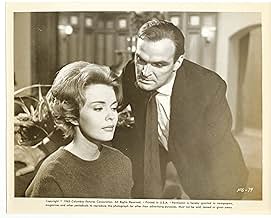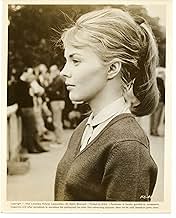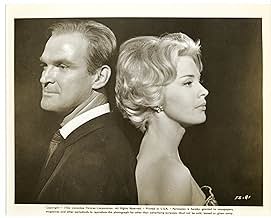CALIFICACIÓN DE IMDb
6.6/10
390
TU CALIFICACIÓN
Una joven estudiante de arte estadounidense debe decidir entre quedarse en París con su novio o regresar a EE. UU. cuando su adinerado padre llega para llevársela.Una joven estudiante de arte estadounidense debe decidir entre quedarse en París con su novio o regresar a EE. UU. cuando su adinerado padre llega para llevársela.Una joven estudiante de arte estadounidense debe decidir entre quedarse en París con su novio o regresar a EE. UU. cuando su adinerado padre llega para llevársela.
Barbara Sommers
- Madame Piguet
- (as Barbara Somers)
James Leo Herlihy
- Dr. John Haislip
- (as James Herlihy)
Claudine Auger
- Clio Andropolous
- (sin créditos)
Jacques Charon
- Patrini
- (sin créditos)
Michel Wyn
- Man with dark glasses in the bar
- (sin créditos)
Opiniones destacadas
She was a very gifted actress, discovered by Otto Preminger and made all kinds of roles, from Saint Joan to a gangster bride of Jean-Paul Belmondo in Jean-Luc Godard's major debut "A bout de souffle" and with Peter Sellers in one of his best comedies, her second marriage was with Roman Gary, who after her death by suicide at 40 blamed the FBI for it for having hounded her by spreading false rumours, but as an actress she was always outstanding. This is a totally different kind of film. Her character and performance here reminds you of Audrey Hepburn in her very subtle and sensitive, and vulnerable style, and the story is a romantic melodrama about love relationships in Paris, and you must regret that Stanley Baker, always excellent in his crude way, didn't get her. It is a wonderful suave and rather melancholy film like a novelletta, and the music is exquisite.
Adapted by Irwin Shaw based on two of his novels, Robert Parrish's vehicle for American actress famous for French films Jean Seberg in IN THE FRENCH STYLE also feels like two movies in one involving two polar opposite romances...
The first with a young and opinionated French local Phillipe Forquet whose uptight, idealistic persona contrasts his innocent boyish looks, and it's unbelievable that Seberg's Christina James... an American on perma-vacation in Paris to become an artist... would have lasted in this relationship for a narrated three months, wherein the best aspects are the actual Paris exterior locations...
Meanwhile the following more grown-up half is mostly shot indoors, from apartment rooms to restaurants to a loud jazzy artsy shindig where the best sequence occurs before Christina's second romance with roving reporter Stanley Baker who, like hedonistic playboy Jack Hedley, treats her with respect but no love, which makes the casting of such a perfectly gorgeous ingenue seem all wrong...
But she hits the right notes when her progressive father visits... their one major sequence as Addison Powell's Mr. James tells Christina exactly what she needs not wants to hear is more interesting than all the sweet-nothings by those random suitors, that not only don't deserve her company but hardly fit the movie...
At least not the one starring Jean Seberg, who often seems like she's being visited by various actor-friends on the set of a much deeper, richer and more intriguing art film than IN THE FRENCH STYLE, which attempts both avant garde detachment and mainstream melodrama while partially failing, twice...
But backed by gorgeous B&W French-travelogue-style cinematography, this particular STYLE is like a moving postcard that's very nice to look at... particularly Seberg, at her most beautiful here: And that's saying something.
The first with a young and opinionated French local Phillipe Forquet whose uptight, idealistic persona contrasts his innocent boyish looks, and it's unbelievable that Seberg's Christina James... an American on perma-vacation in Paris to become an artist... would have lasted in this relationship for a narrated three months, wherein the best aspects are the actual Paris exterior locations...
Meanwhile the following more grown-up half is mostly shot indoors, from apartment rooms to restaurants to a loud jazzy artsy shindig where the best sequence occurs before Christina's second romance with roving reporter Stanley Baker who, like hedonistic playboy Jack Hedley, treats her with respect but no love, which makes the casting of such a perfectly gorgeous ingenue seem all wrong...
But she hits the right notes when her progressive father visits... their one major sequence as Addison Powell's Mr. James tells Christina exactly what she needs not wants to hear is more interesting than all the sweet-nothings by those random suitors, that not only don't deserve her company but hardly fit the movie...
At least not the one starring Jean Seberg, who often seems like she's being visited by various actor-friends on the set of a much deeper, richer and more intriguing art film than IN THE FRENCH STYLE, which attempts both avant garde detachment and mainstream melodrama while partially failing, twice...
But backed by gorgeous B&W French-travelogue-style cinematography, this particular STYLE is like a moving postcard that's very nice to look at... particularly Seberg, at her most beautiful here: And that's saying something.
Robert Parrish did far more work as editor than as director - in fact, IN THE FRENCH STYLE became one of his rare forays into that film-making department. Despite that, he did a commendable job of orchestrating a large number of characters, all of whom emerge as necessary for the piecing together of this tale of human love driven by innocence, learning past innocence, and ultimately convenience.
To that end Parrish is greatly helped by superior performances from his entire cast, down to the minor parts. Jean Seberg as Christina James shines as as the cherry on this delicious cake, not because of the much-repeated and to me needless fact that she is an American residing in Paris but because she is a woman, the universal femme par excellence.
She begins by developing an adolescent relationship with Guy (Philippe Fouquet), who tries to act older than his age, and even warns her that Frenchmen slap back, ultimately correctly predicting that she will in time have many men in her life and ultimately settle with one for economic and social convenience.
As she moves away from the underage Fouquet after the film's first 45 minutes, and gets acquainted with a bunch of handsome and variously interesting men, she has a memorable re-encounter with her father, whom she has not met in four years, and comes to see her in Paris. Addinson Powell, an actor I know nothing about, delivers a short, simple and naturalistic performance as the inevitably interested Dad, who rapidly surmises the pedantic and flash in the pan 1960s scene, and warns his daughter that she may be wasting her time extending her stay in Paris.
In a memorable sequence, Dad sees Christina join a group of models in assorted clothing on a stage for a group photo, and is in fact congratulated on his remarkably scultpural facial features, all of which convince him of un-reality.
Besides tapping so subtly and yet incisively into the 1960s scene, IN THE FRENCH STYLE posts several touches of genius, including never showing the Eiffel Tower although the whole shoot occurs in Paris; and, especially, Stanley Baker making his entrance 50 minutes into the film.
Baker may not be the most handsome of male leads, but as a strapping fellow with penetrating eyes he spots Seberg and they immediately attract to each other. The problem, if they would call it that in the beginning, is that each has other partner exploits on the go. Eventually, Seberg tires of bidding farewell at airports knowing that he will be sharing his bed with other women abroad.
Finally, she picks a man she obviously does not love as much as Baker but one who is a US-based medical doctor and, at the very least, banks a reliable income and enjoys solid social standing. And, of course, she will be returning to her roots outside of heathenish and hedonistic Paris where her physical beauty and social mobility may soon start losing sheen.
The instrumental score by Joseph Kosma deserves the highest plaudits, as does immaculate cinematography by Michel Kelber. Irwin Shaw's book and screenplay are absolute top drawer, too.
Deeply observed must-see film, to me more modern than most of this computer-brained trash we see today that passes for love stories. Or any other stories, for that matter. 10/10.
To that end Parrish is greatly helped by superior performances from his entire cast, down to the minor parts. Jean Seberg as Christina James shines as as the cherry on this delicious cake, not because of the much-repeated and to me needless fact that she is an American residing in Paris but because she is a woman, the universal femme par excellence.
She begins by developing an adolescent relationship with Guy (Philippe Fouquet), who tries to act older than his age, and even warns her that Frenchmen slap back, ultimately correctly predicting that she will in time have many men in her life and ultimately settle with one for economic and social convenience.
As she moves away from the underage Fouquet after the film's first 45 minutes, and gets acquainted with a bunch of handsome and variously interesting men, she has a memorable re-encounter with her father, whom she has not met in four years, and comes to see her in Paris. Addinson Powell, an actor I know nothing about, delivers a short, simple and naturalistic performance as the inevitably interested Dad, who rapidly surmises the pedantic and flash in the pan 1960s scene, and warns his daughter that she may be wasting her time extending her stay in Paris.
In a memorable sequence, Dad sees Christina join a group of models in assorted clothing on a stage for a group photo, and is in fact congratulated on his remarkably scultpural facial features, all of which convince him of un-reality.
Besides tapping so subtly and yet incisively into the 1960s scene, IN THE FRENCH STYLE posts several touches of genius, including never showing the Eiffel Tower although the whole shoot occurs in Paris; and, especially, Stanley Baker making his entrance 50 minutes into the film.
Baker may not be the most handsome of male leads, but as a strapping fellow with penetrating eyes he spots Seberg and they immediately attract to each other. The problem, if they would call it that in the beginning, is that each has other partner exploits on the go. Eventually, Seberg tires of bidding farewell at airports knowing that he will be sharing his bed with other women abroad.
Finally, she picks a man she obviously does not love as much as Baker but one who is a US-based medical doctor and, at the very least, banks a reliable income and enjoys solid social standing. And, of course, she will be returning to her roots outside of heathenish and hedonistic Paris where her physical beauty and social mobility may soon start losing sheen.
The instrumental score by Joseph Kosma deserves the highest plaudits, as does immaculate cinematography by Michel Kelber. Irwin Shaw's book and screenplay are absolute top drawer, too.
Deeply observed must-see film, to me more modern than most of this computer-brained trash we see today that passes for love stories. Or any other stories, for that matter. 10/10.
Beautiful young Jean Seberg (as Christina James) leaves Chicago for Paris, to study painting. There, she meets beautiful young student Philippe Forquet (as Guy), who sits for a portrait. After a few months of dating, Mr. Forquet proposes he and Ms. Seberg have sex. Although she loves him, Seberg is reluctant, and wants to concentrate on forwarding her career; she dreams of becoming the next "Renoir, Matisse, (or) Picasso." Seberg and Forquet try to forge a relationship, but he has a secret. Seberg encounters other men with problems, like reporter Stanley Baker (as Walter Beddoes). Or, is Seberg, herself, the problem?
Robert Parrish's "In the French Style" features excellent black-and-white location photography, by Michel Kelber. The performances are wonderful, and Seberg's carries the film, which loses direction after, to quote, "the years pass quickly," in Paris. This film is almost perfectly divided into two separate stories. The first part, with Seberg and Forquet, is the best. The story falls apart after Seberg's character becomes a modern day "Camille" - for too many minutes into the new drama, you're wondering what happened to the endearing (and extremely beautiful looking) young couple you've been following so far
Forquet makes an additional, brief appearance. His main replacement, Mr. Baker, is given no opportunity to match the romantic build-up of Seberg and Forquet, which hurts the film considerably. After the important, mostly off-screen relationship with Baker gets going, the story switches gears to focus on the arrival of Seberg's father, Addison Powell, in Paris. Father Powell wants Seberg to give up "the life you lead" (meaning men and parties) and return to a more ordinary life in Chicago. Seberg has to make a decision about her future when Baker's (news correspondent) job takes him to the Middle East (a war zone).
Seberg, who ended her life tragically in 1979, should have played "Camille"; she, like the movie, appears so full of potential. Forquet, who really has a handle on his character's age, is exceptional; unfortunately, he began disappearing after "The Young Rebels" (1970). Surprisingly, Powell appeared on TV's "Dark Shadows" (1968); as "Dr. Lang", he temporarily cured Barnabas Collins of vampirism. Fortunately, Baker went directly into lead roles that took better advantage of his worth, like "Zulu" (1964).
******* In the French Style (9/18/63) Robert Parrish ~ Jean Seberg, Philippe Forquet, Addison Powell, Stanley Baker
Robert Parrish's "In the French Style" features excellent black-and-white location photography, by Michel Kelber. The performances are wonderful, and Seberg's carries the film, which loses direction after, to quote, "the years pass quickly," in Paris. This film is almost perfectly divided into two separate stories. The first part, with Seberg and Forquet, is the best. The story falls apart after Seberg's character becomes a modern day "Camille" - for too many minutes into the new drama, you're wondering what happened to the endearing (and extremely beautiful looking) young couple you've been following so far
Forquet makes an additional, brief appearance. His main replacement, Mr. Baker, is given no opportunity to match the romantic build-up of Seberg and Forquet, which hurts the film considerably. After the important, mostly off-screen relationship with Baker gets going, the story switches gears to focus on the arrival of Seberg's father, Addison Powell, in Paris. Father Powell wants Seberg to give up "the life you lead" (meaning men and parties) and return to a more ordinary life in Chicago. Seberg has to make a decision about her future when Baker's (news correspondent) job takes him to the Middle East (a war zone).
Seberg, who ended her life tragically in 1979, should have played "Camille"; she, like the movie, appears so full of potential. Forquet, who really has a handle on his character's age, is exceptional; unfortunately, he began disappearing after "The Young Rebels" (1970). Surprisingly, Powell appeared on TV's "Dark Shadows" (1968); as "Dr. Lang", he temporarily cured Barnabas Collins of vampirism. Fortunately, Baker went directly into lead roles that took better advantage of his worth, like "Zulu" (1964).
******* In the French Style (9/18/63) Robert Parrish ~ Jean Seberg, Philippe Forquet, Addison Powell, Stanley Baker
Wow, despite following Seberg a bit I had never heard of this movie and found it wonderful. I'm a sucker for films about Americans in Europe between the end of the war and before the hippies. Seberg is so desirable (gosh, she looks a lot like Tippi Hedren here) -- people seemed so much more adult at a much younger age. (I recall that line from You've Got Mail where Parker Posey says, Do you believe the Rosenbergs in the picture were around our age?). Always when viewing these films about young women in the late Fifties/early Sixties, I find it poignant to think about them, and how their lives may be changed by the upheavals of the late Sixties. And, of course, that's true of Seberg. Anyway, the movie is a treat -- watch it.
¿Sabías que…?
- TriviaThis was the first and only feature film to be produced by the eminent writer Irwin Shaw (although he later produced a documentary film). Shaw had expressed loud and frequent dissatisfaction with earlier films based on his work (although the then-anonymous critic of "Time" magazine accused him of "crying into his champagne"), and decided that this screenplay, which he had adapted from two of his own short stories, would be protected if he produced the film himself, with his close friend Robert Parrish directing. The film was well-received by critics - though not the "Time" writer, who said that, if Shaw carried on like this, he would soon be "crying into his beer".
- ConexionesReferenced in You Must Remember This: Jean vs "Lilith" (Jean & Jane Part 4) (2017)
Selecciones populares
Inicia sesión para calificar y agrega a la lista de videos para obtener recomendaciones personalizadas
Detalles
Taquilla
- Presupuesto
- USD 750,000 (estimado)
- Tiempo de ejecución1 hora 45 minutos
- Color
- Relación de aspecto
- 1.66 : 1
Contribuir a esta página
Sugiere una edición o agrega el contenido que falta

Principales brechas de datos
By what name was Al estilo francés (1963) officially released in India in English?
Responda



























